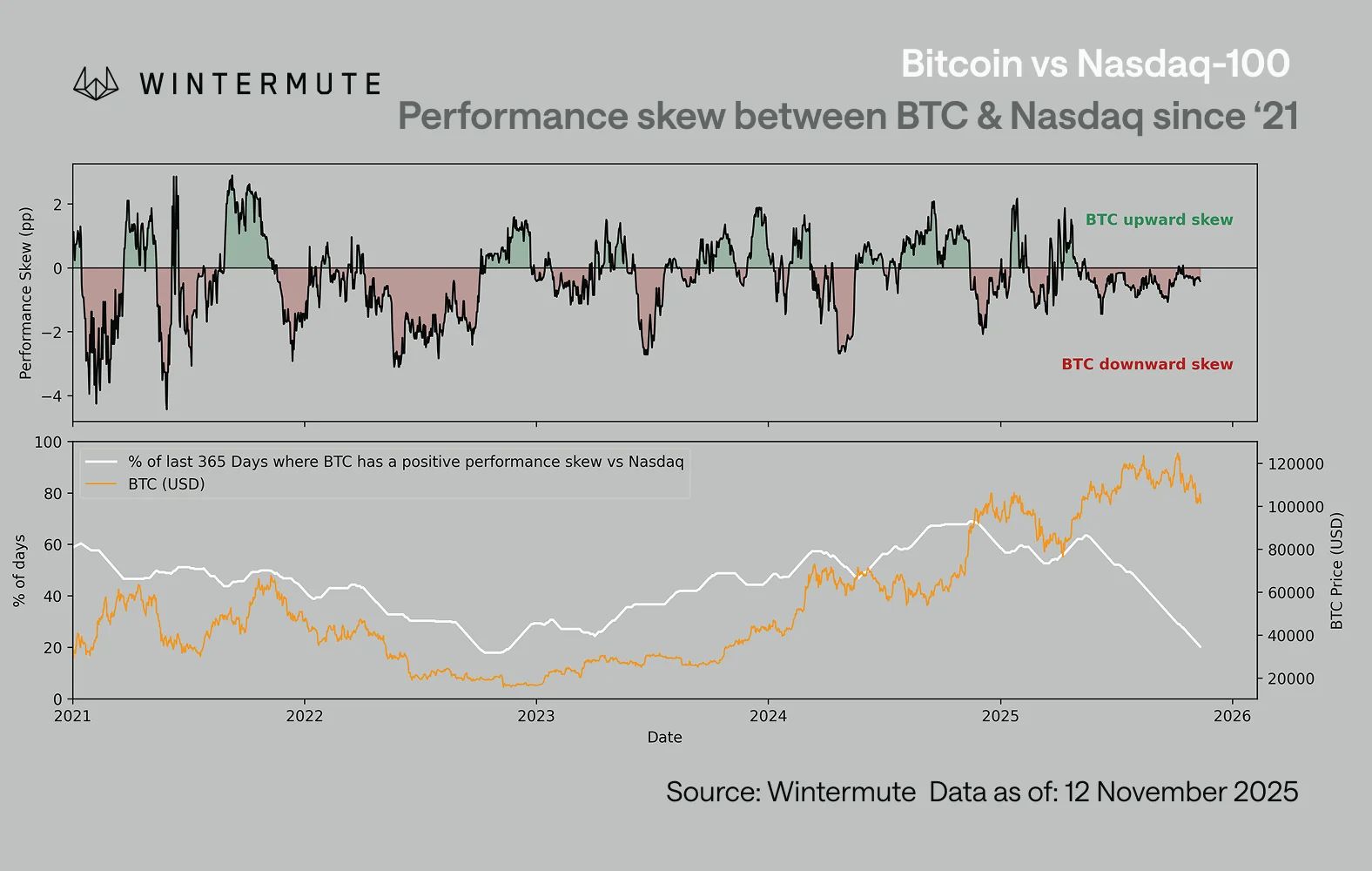Bitcoin Falls Harder Than Tech as Nasdaq Link Tightens and Skew Turns Negative
Bitcoin’s correlation with the Nasdaq has surged while its relationship with gold has nearly vanished, pushing the asset deeper into tech-stock territory. Analysts warn that thin liquidity and bearish skew now define its market behavior.
Bitcoin’s 30-day correlation with the Nasdaq 100 Index has surged to its highest level in 3 years. Meanwhile, its link to traditional safe-haven assets, such as gold, has dropped to nearly zero.
This significant shift raises questions about Bitcoin’s digital gold narrative as it now acts more like a high-beta technology asset than a stable store of value.
Bitcoin Mirrors Tech Stock Volatility as Market Dynamics Shift
In a recent post on X (formerly Twitter), The Kobeissi Letter highlighted that the cryptocurrency’s 30-day correlation with the Nasdaq 100 Index has reached roughly 0.80. This was the highest reading since 2022 and the second-strongest level in the past decade.
Bitcoin’s correlation with equities turned positive in 2020. Over the last five years, the largest cryptocurrency has generally moved in the same direction as the tech-heavy index. It only broke that pattern for short stretches in 2023.
This long-running trend has now pushed Bitcoin’s five-year correlation with the Nasdaq to 0.54. Meanwhile, The Kobeissi Letter noted that Bitcoin shows almost no statistical relationship with assets traditionally viewed as safe havens, including gold.
“Bitcoin is increasingly behaving like a leveraged tech stock,” the post read.
Furthermore, in its latest report, Wintermute pointed to a more pressing dynamic: the quality of the correlation has shifted. The firm explained that while the directional correlation with the Nasdaq remains elevated, its quality has deteriorated into a bearish skew. This means that,
- When equities fall, BTC falls harder.
- When equities rise, BTC participates weakly.
“Right now, that skew is firmly negative, showing that BTC still trades as a high-beta expression of risk sentiment, but only when it cuts the wrong way,” the analysis reveals.
 Bitcoin and Nasdaq Correlation. Source:
Wintermute
Bitcoin and Nasdaq Correlation. Source:
Wintermute
Notably, the “pain gap,” has surged to levels not seen since late 2022. This results in a structural performance disadvantage, where Bitcoin underperforms in risk-on environments—characterized by investor optimism—and overreacts in risk-off scenarios, amplifying downside moves.
Wintermute’s Jasper De Maere revealed that two forces explain why this skew is appearing now. First, investor mindshare has shifted toward equities, especially mega-cap tech. It has absorbed most of the risk-on flows that previously rotated into crypto.
“This crowding of mindshare means BTC remains correlated when global risk sentiment turns, but doesn’t benefit proportionally when optimism returns. It reacts as a ‘high-beta tail’ of macro risk rather than a standalone narrative, the downside beta remains, the upside narrative premium does not,” De Maere stated.
Second, structural liquidity in crypto remains thin. Stablecoin supply has stalled, ETF inflows have slowed, and exchange depth has not recovered to early-2024 levels. This fragile liquidity amplifies downside moves, reinforcing the negative skew.
“Historically, this kind of negative asymmetry doesn’t appear near tops but rather shows up near bottoms. When BTC falls harder on bad equity days than it rises on good ones, it usually signals exhaustion, not strength,” the report added.
Market data further corroborates this. Over the past 41 days, the crypto sector has shed $1.1 trillion in market capitalization, equating to $27 billion daily. Bitcoin itself has dropped 25% in the last month, moving below $95,000 amid a broader sell-off.
“US stock market futures just opened and they are completely unfazed by the crypto decline this weekend. Even as crypto has lost -$100 billion since Friday, US stock market futures are GREEN,” The Kobeissi Letter reported.
Furthermore, gold has surpassed $4,100 per ounce, outperforming Bitcoin by 25 percentage points since early October. According to The Kobeissi Letter,
“The isolated nature of the -25% crypto downturn further supports our view: This is a leverage and liquidation-based crypto ‘bear market.'”
Taken together, these developments raise a crucial question for investors: can Bitcoin still be viewed as a safe-haven asset? With correlations elevated, liquidity thin, and downside reactions outweighing upside participation, the current data points to a market where Bitcoin behaves more like a high-beta speculative asset than a defensive hedge.
Whether this dynamic proves temporary or structural will depend on how risk sentiment, liquidity conditions, and investor positioning evolve in the months ahead.
Disclaimer: The content of this article solely reflects the author's opinion and does not represent the platform in any capacity. This article is not intended to serve as a reference for making investment decisions.
You may also like
Dogecoin News Today: Institutional Altcoin ETFs Resist Crypto Market Downturn
- Grayscale and VanEck launch Dogecoin/Solana ETFs as crypto markets decline, defying broader outflows. - U.S. spot Bitcoin ETFs see $870M outflows; Ethereum ETFs lose $259.7M amid third-week withdrawal streak. - Institutional altcoin ETFs gain traction with $550M+ assets, signaling growing crypto legitimacy in portfolios. - Ethereum's 3.6M token treasury and Fusaka upgrade optimism contrast with 4% ETF outflows of AUM. - Persistent retail caution contrasts with institutional adoption, as crypto's traditio

Bitcoin News Update: Blockchain.com’s Co-CEOs Steer Through Crypto Market Fluctuations as Company Relocates Headquarters to Texas
- Blockchain.com appoints Lane Kasselman as co-CEO alongside Peter Smith, adopting a dual leadership model to enhance operational efficiency during transition. - The firm relocates its U.S. headquarters to Dallas, Texas, leveraging the state's tax incentives, regulatory flexibility, and proximity to the Texas Stock Exchange. - This move aligns with broader corporate trends in Texas, as companies like Coinbase and McKesson shift operations to capitalize on business-friendly policies and innovation hubs. - T

Bitcoin Updates Today: Is Bitcoin’s Drop Indicating a Bear Market or Revealing Foundational Strength?
- Bitcoin's drop below $95,000 triggered a 2.8% S&P 500 decline, raising fears of synchronized market downturns. - American Bitcoin (ABTC) reported $3.47M profit but shares fell 13% as BTC price erosion offset mining gains. - 43-day U.S. government shutdown created information vacuum, while $869M Bitcoin ETF outflows highlighted investor panic. - Fed rate cut odds dropped to 45% amid inflation concerns, with analysts warning of cascading price drops below $90,000. - Institutional ETF adoption and $835M Mic

Hyperliquid News Today: Goldman: AI's $19 Trillion Buzz Surpasses Actual Progress, Bubble Concerns Rise
- Goldman Sachs warns U.S. stock markets have overvalued AI's economic potential, pricing $19T gains ahead of actual productivity impacts. - The bank identifies "aggregation" and "extrapolation" fallacies as key risks, mirroring historical tech bubbles from 1920s/1990s over-optimism. - AI expansion extends beyond tech sectors, with blockchain compliance tools and energy management markets projected to grow via AI integration. - Regulatory challenges persist as DeFi collapses expose gaps in AI token definit

